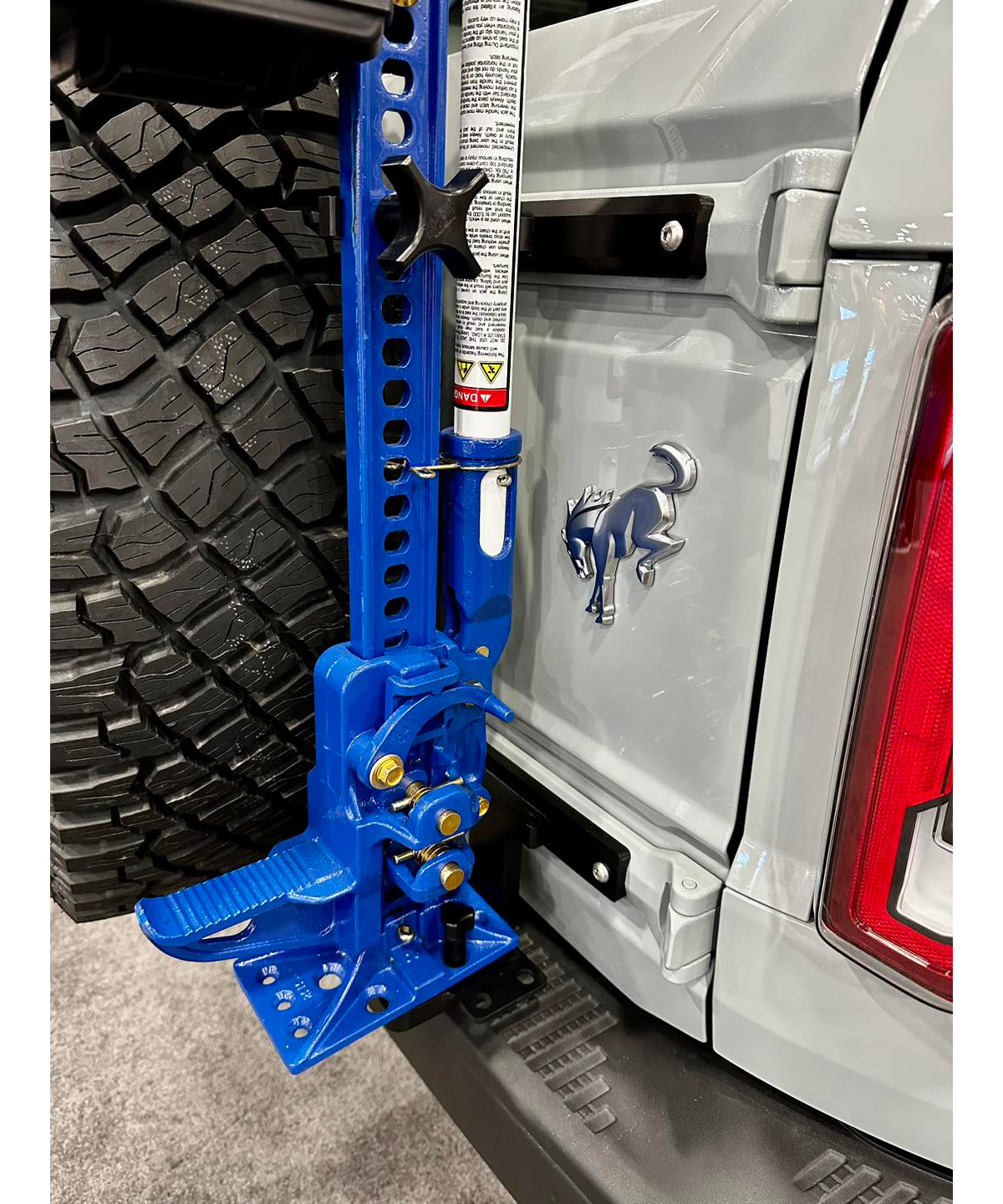For my final article on recovery gear you should carry in your Bronco, I’m going to touch on recovery jacks. These are certainly not essential pieces of recovery gear; many can spend years driving off-road and never need one. They have never been a standard part of my kit until very recently, and I’ll explain why I had a change of heart –– maybe you will decide to store one on-board too.
Never change a tire with a recovery jack.
Recovery jacks are very different from standard jacks used to change tires and serve different purposes. Standard jacks are an essential piece of gear. You’ll always want to make sure you have that piece of equipment in your Bronco, as a tire change on the trail is likely to happen, and AAA probably won’t be nearby. In fact, on Rally, when I get a flat, I use the stock scissor jack that comes with my Bronco Sport and a battery-powered impact for a quick and easy change. If your stock jack won’t work due to your modifications or total weight of your vehicle, a nice heavy-duty bottle jack is a good go-to.
A recovery jack, by comparison, is used to get you unstuck. Use one to temporarily lift the vehicle so you can place a traction board, or even rocks, under a tire for clearance or traction. A recovery jack is NOT meant to be used to change a tire or hold your Bronco in a stable spot while you do a trail repair. You should never get under your Bronco, held up by a recovery jack, EVER! People have become injured and even killed by vehicles that fell off a jack.
I’m going to discuss three types of recovery jacks:
- Hi-Lift Jacks
- ARB Hydraulic Jacks
- ARB Air Bag Jacks
Hi-Lift Jacks require training and practice.

image: Hi-Lift
Probably the most common of recovery jacks, the Hi-Lift uses a dual pin mechanism to lift or lower a load. It is a sturdy design that has changed little in more than 100 years, and it is the most affordable of the jacks I’ll mention. It would be rare to be on a group trail ride and fail to see a Hi-Lift. This is a great jack for the properly trained, and it has additional functionality as a winch. I’ve seen people get creative with the Hi-Lift and use it as bracing in field repairs. Many have gotten off the trail thanks to this jack.
When I began my off-roading lifestyle, I thought a Hi-Lift jack was an off-road requirement because it seemed like all the big rigs had them, so I invested in one immediately, never learned how to use it, and, in fact, never did use it. Someone borrowed it on a trail ride within my first year of ownership, and it disappeared from there, which was probably a good thing as I had no idea how to properly use it. Let me mention that a Hi-Lift jack is not very stable and not very easy to use, and it requires some strength to use it. Kickback from the handle is a real concern, and people have been injured or killed when not using it or maintaining it correctly. If you have one, you need to know exactly how to use it and how to take care of it.
I ended up taking a hands-on class offered during an Easter Jeep Safari, and these types of classes are often offered free of charge at overlanding and other off-road events and expos. Also, read the manual and follow it carefully.

Hi-Lift jacks require regular maintenance.
I also typically see Hi-Lift jacks mounted in places where they cannot be adequately maintained or easily accessed. If you’ve invested in your jack as a hood decoration, expect that it will not function when you need to use it, especially if you live in a wet climate. I watched a gentleman spend 30 minutes just trying to get the Hi-Lift off his Jeep; he had mounted it with bolts and wires, and the weather had rusted all those bolts and wires in place. Once he did get the jack free, the mechanisms were rusted in place as well, making it a useless piece of metal. A Hi-Lift jack needs to be oiled to function, even for the first use, and should be stored upright in a dry location whenever possible. Don’t let a complex recovery be your first opportunity to try out your jack. It’s not likely to go well.
Why I never carried a recovery jack until now.
To go back to my early off-roading days, I discovered quickly that in most situations, I did not need a recovery jack, so I never carried one. There were plenty of other ways to get unstuck, in my opinion. I’ve mentioned many of those tools in my previous recovery articles. I changed my mind just this year, and it was due to being offered a different jack to use in the Rebelle Rally.
Part of this year’s Ford Performance recovery gear included a product from ARB called the Hydraulic Recovery Jack.

It was packed nicely in my Bronco Sport and just prior to the Rally, I decided to try it to see if I was taking it or leaving it behind in the garage. Now I’m not one to get geeked out by gadgets, but this device did it for me. I also wasn’t sure if the Bronco Sport was the right vehicle for this jack, it being big, and the Sport being small; but I was proven wrong. It is intuitive and easy to use, and the hydraulic mechanism was a piece of cake. I practiced lifting the Sport with a soft shackle around the wheel and using the jack points on the car. The hydraulic action made it so easy. I decided it made the cut to come on Rally and might come in handy to lift the wheel if I got buried in the sand, something I’ve been known to do a time or two.
One never expects to get stuck on concrete.
What I didn’t think would happen though, is that I would become hopelessly stuck on concrete. I’ve mentioned this story in other articles, but sometimes truth is stranger than fiction and I made a poor decision to drop the car off a ledge at the end of a tunnel that traveled under an active railroad track.

The body of the car was on the edge of the drop-off, and we were high centered. My co-driver Jessica tried getting a rock under the tire, which did nothing. I got out to help, and we wedged traction boards, rocks, anything we could find, but nothing could move the car from its resting point. I had one more idea to try before we resorted to calling on the satellite phone for rescue and a penalty, and that was to use the jack. The Bronco Sport has a laughably tiny rear recovery point that actually works, but it sure looks flimsy. As it was already attached, I decided to try this for a jacking point for the jack (I’m full of bad ideas; don’t try this at home). A few quick pumps from the hydraulic handle, and a lot of pops and creaks from the poor recovery point, allowed us to fully wedge the traction boards under the tires. I left the jack in place and went for it. The car was freed, and we cheered. If I wasn’t a fan before, I sure am one now. Now, to be clear, I violated several “Do Nots” in this recovery, and I’m not recommending the jack to be used the way I did. The Hydraulic Recovery Jack has a manual, and you should follow it.
Now, before you put this on your Christmas list, check the price. It’s not inexpensive, but if you’re that guy or gal who makes a habit out of getting stuck, or wants to be ready when you do, it might be something you’d like to invest in.
You could also use an air bag jack.

One other product I’d like to discuss but have not had the opportunity to try is an air bag jack. The ARB X-Jack splits the price point between the Hi-Lift and the ARB Hydraulic Recovery Jack. It can be inflated using either an air compressor or the vehicle’s own exhaust. This type of jack would work well in terrains that are less than stable, such as in snow, mud, or sand but may be challenging with sharp rocks that could tear it. The other nice thing about this product is that you don’t need much clearance to engage it. Only a few inches between the ground and the jacking point are required, so being buried in the sand may require less digging than with another type of jack.
The downside to this product would likely be the possibility of puncturing and causing damage to the air bag, although the manual does give suggestions to reduce the risk of damage, and the product looks sturdy. It also looks like it may take a bit of time to put away after use. There is also some maintaining of the product, and it should be inflated every three months to prolong the life. If anyone has used this type of recovery jack, I’d love to read about your thoughts in the comments.
Recovery jacks are nice to have but not critical.
In summary, recovery jacks are what I would list as one of my “nice to haves,” not a must-have in the Bronco. If you like to get out there alone or plan on spending a few days in remote areas, or if you push the boundaries of what your Bronco can do and where it can go, a recovery jack might be just what you’re looking for. If you do decide to invest in one, please take the time to understand your jack. Make sure you’re familiar with its use, and practice with it before you head out on your next adventure.
Recovery Jacks by ARB
Looking for a jack in the Bronco Nation store? Check out these by ARB. Your member discount applies! Plus, find other recovery items for your Bronco in the Recovery Gear section.


Comments
You must log in or register to post here.